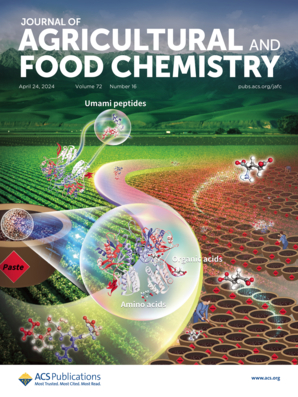Jasmonic Acid Signaling Pathway Mediates Decabromodiphenyl Ethane (DBDPE) Tolerance by Modulating Photosynthesis and Oxidative Stress in Sugar Beet: Insights from Integrative Physiological and Multiomics Analyses
IF 5.7
1区 农林科学
Q1 AGRICULTURE, MULTIDISCIPLINARY
引用次数: 0
Abstract
Decabromodiphenyl ethane (DBDPE), an emerging ubiquitous contaminant, enters the food chain through crop bioaccumulation, threatening food safety. This study investigated the bioaccumulation, toxicity, and tolerance mechanisms of DBDPE in sugar beet. The results showed that DBDPE was absorbed by roots and transported to leaves in a constant proportion, with greater toxicity in leaves than in roots. Physiological analyses revealed that DBDPE induced chloroplastic dysfunction and oxidative stress in a concentration-dependent manner. The antioxidant system in response to DBDPE varied with exposure levels. Integrated transcriptomic, proteomic, and metabolomic analyses revealed that remodeling of jasmonic acid (JA) biosynthesis and consequent activation of JA signaling were critical for DBDPE tolerance. Exogenous JA and JA-Ile (active JA) maintained photosynthetic activity by protecting chloroplasts and mitigated oxidative damage by enhancing antioxidant system activity, thereby improving DBDPE tolerance. This study provides an insight into the development of effective mitigation strategies against DBDPE toxicity in crops.

茉莉酸信号通路通过调节甜菜光合作用和氧化应激介导十溴二苯乙烷(DBDPE)耐受性:来自综合生理和多组学分析的见解
十溴二苯乙烷(DBDPE)是一种新兴的无所不在的污染物,通过作物生物积累进入食物链,威胁食品安全。本研究探讨了DBDPE在甜菜中的生物蓄积、毒性和耐受性机制。结果表明,DBDPE被根吸收并以一定比例转运到叶片中,叶片的毒性大于根。生理分析显示,DBDPE以浓度依赖性方式诱导叶绿体功能障碍和氧化应激。抗氧化系统对DBDPE的反应随暴露水平而变化。综合转录组学、蛋白质组学和代谢组学分析表明,茉莉酸(JA)生物合成的重塑和随之而来的JA信号的激活对DBDPE耐受性至关重要。外源JA和JA- ile(活性JA)通过保护叶绿体维持光合活性,通过增强抗氧化系统活性减轻氧化损伤,从而提高DBDPE耐受性。本研究为制定有效缓解DBDPE对作物毒性的策略提供了见解。
本文章由计算机程序翻译,如有差异,请以英文原文为准。
求助全文
约1分钟内获得全文
求助全文
来源期刊
CiteScore
9.90
自引率
8.20%
发文量
1375
审稿时长
2.3 months
期刊介绍:
The Journal of Agricultural and Food Chemistry publishes high-quality, cutting edge original research representing complete studies and research advances dealing with the chemistry and biochemistry of agriculture and food. The Journal also encourages papers with chemistry and/or biochemistry as a major component combined with biological/sensory/nutritional/toxicological evaluation related to agriculture and/or food.

 求助内容:
求助内容: 应助结果提醒方式:
应助结果提醒方式:


